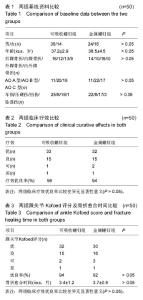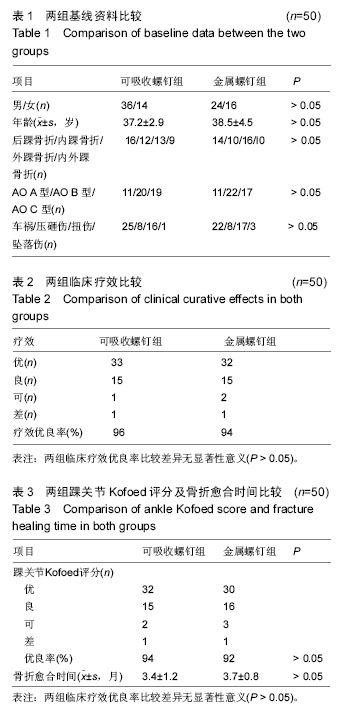| [1] 罗兵,龙雳,李俭东,等.可吸收螺钉在髌骨骨折中的治疗分析[J].中国现代医生,2008,46(14):25-26.
[2] 邱斌,曹建民,廖贵华,等.可吸收螺钉在近关节端松质骨骨折中的应用[J].中国当代医药,2009,16(3):10-11.
[3] 周荣华.可吸收螺钉治疗踝关节骨折23例疗效分析[J].海南医学院学报,2011,15(7):954-956.
[4] 徐义祥,曾仲达,林水平,等.手术治疗躁关节骨折的疗效分析[J].中外医学研究,2013,11(35):133-134.
[5] 侯俊,杨元勋,黄建城,等.可吸收螺钉治疗足踝关节周围骨折29例[J].中国实用医刊,2012,39(17):78-79.
[6] 张建国.手法整复外固定与切开复位内固定治疗踝关节骨折的临床疗效观察[J].中国医学创新,2012,9(31):29-30
[7] 徐德兴.可吸收螺钉治疗关节周围松质骨骨折42例[J].实用医学杂志,2010,26(12):2258-2259.
[8] 茁二春.金属加压螺钉辅助可吸收螺钉治疗内踝骨折的临床疗效分析[J].中国实用医药,2014,27(3):91-92.
[9] 施伟业,黄家基,黄侣,等.可吸收螺钉治疗内踝骨折的临床疗效[J].微创医学,2011,6(2):139-140.
[10] 何秀成.可吸收螺钉内固定术治疗足踝部骨折的疗效观察[J].中国现代药物应用,2012,7(24):66-67.
[11] 黄建华.可吸收螺钉内固定治疗关节内骨折的疗效分析[J].当代医学,2009,15(31):63-64.
[12] 王彬,钟丹,周祖华.可吸收螺钉治疗踝关节骨折的疗效分析[J].求医问药(下半月),2012,22(3):477-478.
[13] 邢涛.可吸收螺钉内固定术联合中药熏洗治疗单纯内踝骨折疗效观察[J].中国中医药信息杂志,2011,36(18): 556-559.
[14] 唐可,王诗波,骆宇春,等.后踝骨折的研究进展[J].安徽医药, 2014,18(3):418-422.
[15] 孙劲,黄晖,付纳新,等.PLLA可吸收螺钉和金属松质骨螺钉治疗Jones骨折的疗效比较[J].中国矫形外科杂志, 2013, 21(24):2525-2527.
[16] 倪明,厉国定,胡晓亮,等.生物可吸收材料在踝足骨折治疗中的应用[J].生物骨科材料与临床研究,2012,9(1):45-47.
[17] 廖朝雨.可吸收螺丝钉与钛合金金属螺丝钉治疗踝部骨折的临床疗效对比[J].健康之路,2014,10(3):154-154.
[18] 陈刚,管军辉,安洪宾,等.可吸收螺钉与钛合金金属螺钉在踝部骨折中的应用对比[J].医学理论与实践,2011,24(17): 2076-2077.
[19] 胡亚军.可吸收螺钉治疗踝关节骨折临床应用及疗效分析[J].当代医学,2012,18(15):53-54.
[20] 杜继忠,孙喜悦,魏鹏可吸收螺钉治疗踝关节骨折13例临床分析[J].中国煤炭工业医学杂志,2013,13(4):602-603.
[21] Noh JH,Roh YH,Yang BG,et al.Outcomes of operative treatment of unstable ankle fractures: a comparison of metallic and biodegradable implants.J Bone Joint Surg Am.2012;94(22):e166.
[22] Kukk A,Nurmi JT.A retrospective follow-up of ankle fracture patients treated with a biodegradable plate and screws.Foot Ankle Surg.2009;15(4):192-197.
[23] Liu JG,Ma WH,Xu XX.Orthopaedic applications for biodegradable and absorbable internal fixation of fractures.Zhongguo Xiu Fu Chong Jian Wai Ke Za Zhi. 2002;16(3):209-211.
[24] Su Y,Xie Y,Qin J,et al.Internal Fixation With Absorbable Rods for the Treatment of Displaced Radial Neck Fractures in Children.J Pediatr Orthop.2015[Epub ahead of print]
[25] Thordarson DB,Samuelson M,Shepherd LE,et al. Bioabsorbable versus stainless steel screw fixation of the syndesmosis in pronation-lateral rotation ankle fractures: a prospective randomized trial.Foot Ankle Int.2001;22(4):335-338.
[26] Zhang J,Ebraheim N,Lausé GE,et al.A comparison of absorbable screws and metallic plates in treating calcaneal fractures: a prospective randomized trial.J Trauma Acute Care Surg.2012;72(2):E106-110.
[27] Hu YL,Yuan WQ,Wang LF,et al.A prospective randomized trial of poly-DL-lactic acid absorbable and metallic screws for treatment of syndesmotic disruptions. Nan Fang Yi Ke Da Xue Xue Bao.2010; 30(10):2360-2362.
[28] Zhao L,Li Y,Chen A,et al.Treatment of type C pilon fractures by external fixator combined with limited open reduction and absorbable internal fixation. Foot Ankle Int. 2013;34(4):534-542.
[29] Tang J,Hu JF,Guo WC,et al.Research and application of absorbable screw in orthopedics: a clinical review comparing PDLLA screw with metal screw in patients with simple medial malleolus fracture. Chin J Traumatol. 2013;16(1):27-30.
[30] Noda M,Yoshino K,Honda H,et al.A comminuted talar body fracture osteosynthesized with bioabsorbable screws: a case report.J Trauma.2004;56(3):709-712.
[31] Sun H,Li Q,Tang X,et al.Effectiveness of mini incision and absorbable screw fixation for treatment of anterior cruciate ligament tibial eminence avulsion fracture. Zhongguo Xiu Fu Chong Jian Wai Ke Za Zhi.2014; 28(9):1072-1076.
[32] Ibrahim AM,Koolen PG,Kim K,et al.Absorbable biologically based internal fixation. Clin Podiatr Med Surg.2015;32(1):61-72.
[33] Ouyang ZS,Li Q,Li J.Absorbable screw fixation for the treatment of tibial avulsion fracture of the tibial attachment of the posterior cruciate ligament through posterior middle mini incision of knee joint].Zhongguo Gu Shang.2013;26(9):720-723. |

